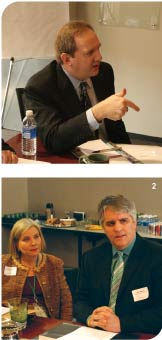
1: Nick Franano, Proteon Therapeutics, seeks improved relations between private enterpriseand area universities. | 2: Roy Jensen, University of Kansas Cancer Center, addressed Franano’s concerns while Linda Cook listened.
David Adkins, vice chancellor for external affairs at the University of Kansas Medical Center, believes that the stage has been set for the emergence of translational research in Kansas City.
He foresees two immediate challenges, however: the stagnation of federal funding and the difficulty of developing a functional model of how universities and businesses can effectively work together. “Universities,” he said, “are currently struggling with how to make that possible.”
Franano affirmed just how difficult those relationships could be. As much as he would like to engage the university, as a private sector biotechnology person “You immediately get into arguments over who owns what, for how long, how much you have to pay, what are the upfront commitments. You get drowned in all these details of the university trying to capture every last dollar in the legal agreement and then you just throw up your hands and say ‘It’s not worth working with the universities.’”
“Success needs to be defined not by how much money you’re able to able to secure in the original agreement, ”affirmed Adkins, “but by how many deals you’re doing. It is a matter of volume.”
“It’s a new reality that everyone is facing when they finally realize that our competition is not each other,” added Roy Jensen. “Our competition is M.D. Anderson and Mayo and Dana-Farber and Stanford and places like that.”
Entrepreneurialism
Jeff Biskup, principal and founder of Clark Richardson & Biskup (CRB), commented that in established biotech regions, the interchange between university researchers and commercial developers is much freer. He believes that university administrators should try “to get the kids out of the nest,” meaning to push their academic researchers into the commercial world.
Although keen on collaboration, Tom Thornton applauded KU for having approached commercialization “like an entrepreneurial company would interms of their go to market strategy.” Nick Franano took exception to that positioning strategy. “Companies are companies,” he noted. “So the best thing to do would be to let those researchers go start companies, get stock, raise capital, develop products, and then cash out, do well for their patients and themselves and then give the money back.”
“You can’t create companies from the top down,” Franano added. “They have to come from the bottom up.”
Spigarelli agreed. “One of the original purposes of the Life Sciences Institute was to get these institutions to create the culture that would foster the individual spinouts.”
Roy Jensen wondered whether KU’s intentions had been misinterpreted. KU, he argued, is thinking entrepreneurially in trying to identify research that may have ultimate commercialization potential. “There is,” he added, “no attempt whatsoever to contain the ultimate commercialization within the university.”
Franano sympathized with the university’s desire to see its research commercialized as well as with its frustra-tion with not having companies readily available “to hand that stuff off to.”
National Bio and Agro-Defense Site
Kansas State remains in the running for the National Bio and Agro-Defense Facility, the proposed new $451 million federal lab. Despite its ungainly acronym, NBAF, pronounced pretty much as it looks, would be a major coup for animal health research in the region. The site will be announced in six months.“
DHS [Department of HomelandSecurity] probably wants us to sit back and wait for the record of decision,” said Tom Thornton. “We are not doing that. Kansas and our partners here, certainly K-State and the state of Kansas, have taken a very proactive approach to this.”
“Almost every organization and individual around this table in some way has contributed to this NBAF effort, ”Thornton said. “It is not just the KBA. It is not K-State. The level of collaboration here is truly extraordinary.”
Ron Trewyn said there isn’t anywhere in this country to tackle serious livestock diseases. Wherever it goes, NBAF will be a “critical and a great opportunity.” The Kansas Bioscience Authority hasbeen working on developing a consortium around this effort. The KBA, in fact, has recruited nine governors from surrounding states to support the effort in Kansas.
Duncan said the region’s AnimalHealth Corridor has been a significant supporter of NBAF. Thornton agreed. “What makes NBAF more compelling both nationally and regionally is hooking NBAF in with that dense concentration ofanimal health companies” in the region.
There is, however, as Trewyn acknowledged, “alot of misinformation about